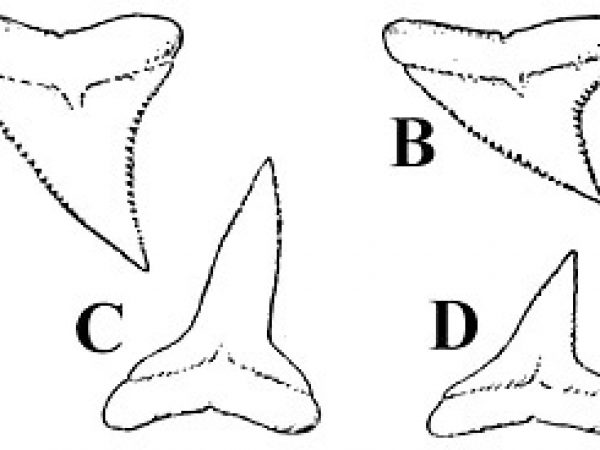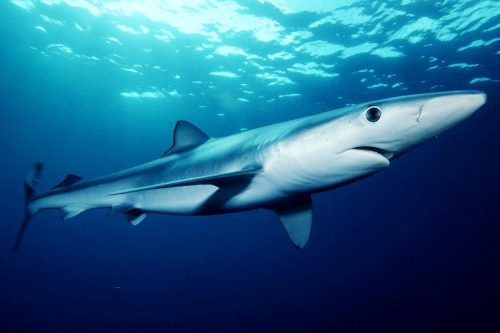
Prionace glauca
Blue sharks are pelagic sharks commonly named for their distinct blue color that fades to a crisp white underside. They have a long, sleek body and an elongated conical snout. They are often seen swimming slowly at the surface with the tips of their dorsal and caudal fins out of the water. Although blue sharks are not usually aggressive, they are curious animals, known to approach divers, especially spearfishers when food is involved (Compagno et al. 2005).
Order – Carcharhiniformes
Family – Carcharhinidae
Genus – Prionace
Species – glauca
Common Names
English language common names include blue shark, blue dog and blue whaler. Other common names
blouhaai (Afrikaans)
peshkagen (Albanian)
kalb al bhar (Arabic)
Modrulj (Croatian)
blåhaj (Swedish, Danish)
blauwe haai (Dutch)
sinihai (Finnish)
bleu (French)
blauhai (German)
Squalo azzurro (Italian)
yoshikirizame (Japanese)
tubarão azul (Portuguese)
tiburon azul (Spanish)
canavar balik (Turkish)
Cá Mập xanh (Vietnamese)
Importance to Humans
Target commercial fisheries for the blue shark are rare but bycatch rates are high, likely reaching about 20 million individuals caught globally each year. In the United States, Australia, and Europe, blue sharks are considered a sport fish that are known to put up a good fight on light tackle (Stevens 2009).
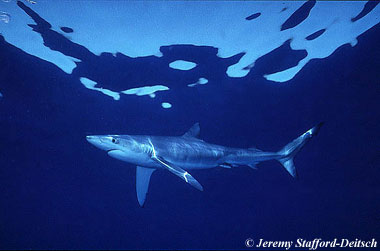
Danger to Humans
The blue shark is relatively unaggressive but is very curious and will approach divers and spearfishers, especially if food is available. According to the ISAF, the blue shark is responsible for thirteen unprovoked shark bites worldwide. Three documented attacks resulted from air or sea disasters and several accounts refer to blue sharks attacking shipwrecked sailors floating in the open ocean. While not overtly aggressive, it is not a timid shark and should be approached with caution, especially if it has been circling since it may attempt an exploratory bite in test feeding (ISAF 2018).
View shark attacks by species on a world mapConservation
IUCN Red List Status: Near Threatened
The blue shark is the most heavily fished shark in the world (Compagno et al. 2005) with annual global catch estimates of around 20 million individuals each year. This species is rarely targetted commercially but bycatch by longline and driftnet fisheries is very high. Blue shark catches are included in the regulated commercial longline shark fishery on the Atlantic and Gulf coasts of the United States. The entire fishery is limited to landing 580 metric tons dry weight of pelagic shark species. Fishery assessments are limited but showed no evidence of population decline when the census was conducted 10 years ago (Stevens 2009). The main conservation issue that needs to be addressed is minimizing mortality rates of blue sharks caught as bycatch.
> Check the status of the blue shark at the IUCN website.
The IUCN is a global union of states, governmental agencies, and non-governmental organizations in a partnership that assesses the conservation status of species.
Geographical Distribution
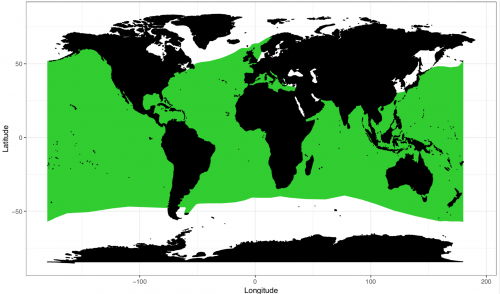
Blue sharks can be found in temperate and tropical oceans from latitudes of 60°N to 50°S (Stevens 2009). They are a pelagic species that rarely comes near shore but have been known to frequent inshore areas around oceanic islands and locations where the continental shelf is narrow (Compagno et al. 2005). They can be found at depths ranging from the surface to 350 meters (Stevens 2009).
Habitat
Being a pelagic species the blue shark’s habitat consists of open ocean areas from the surface to 1,148 ft (350 meters) in depth. They prefer cooler water ranging from 12-20°C. When in the tropics the blue shark seeks deeper waters with cooler temperatures (Stevens 2009). At night, blue sharks often swim inshore around oceanic islands (Compagno et al. 2005).
Distinguishing Characteristics
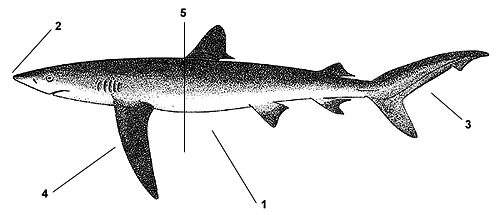
1. Body is slender
2. Snout is long and rounded
3. Caudal fin is heterocercal
4. Pectoral fins are very long and pointed
5. First dorsal fin is closer to pelvic fins than pectoral fins
Biology
Distinctive Features
The blue shark has a slender body with a large eye and a long conical snout that is longer than the width of its mouth. It has extremely long, pointed pectoral fins, which are typically as long as the distance from its snout to posterior gill slit. The dorsal fin is moderate in size and set back where it is actually closer to the pelvic fin insertion than the pectoral insertion point. There is a slight keel on the caudal peduncle and the tail is narrowly lobed with a long ventral lobe (Compagno et al. 2005).
Coloration
The blue shark’s name comes from its distinct dark blue dorsal surface. The ventral surface is a well-defined, crisp white color (Compagno et al. 2005). This contrast in colors is known as counter-shading and provides camouflage for the shark in the open ocean.
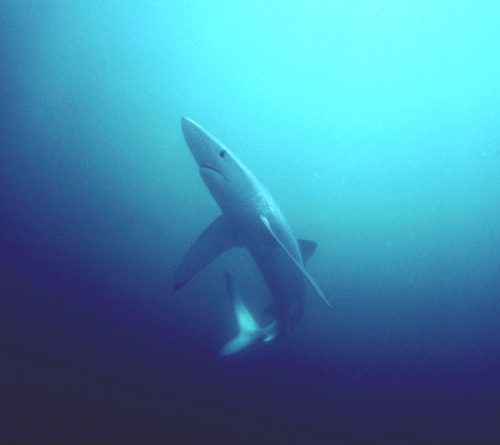
Dentition
The upper teeth of the blue shark are highly distinctive in shape. They are triangular with highly recurved cusps, strongly serrated edges and bases that overlap each other. The upper jaw generally has one symmetrical median (symphysial) tooth and 14 teeth on either side of the upper jaw. Teeth on the lower jaw number 13 to 15 on either side and have more finely serrated edges than those in the upper jaw, nearly erect cusps and more symmetrical in shape than the upper jaw teeth (Bigelow and Schroeder 1948).
Denticles
Dermal denticles are closely arranged, typically overlapping and small. The blades are broad with usually 3, but up to 4 or 5 ridges. The skin is smooth to the touch (Bigelow and Schroeder 1948).
Size, Age, and Growth
The maximum size for the blue shark is about 380 cm (Compagno et al. 2005, Stevens 2009). Males are believed to be mature at 4-6 years of age and at lengths between 6 and 7 feet (182-218 cms). Females mature at slightly older ages than males (5-7 years) and longer lengths (7 feet (221 cms). The lifespan is believed to be more than 20 years (Stevens 2009).
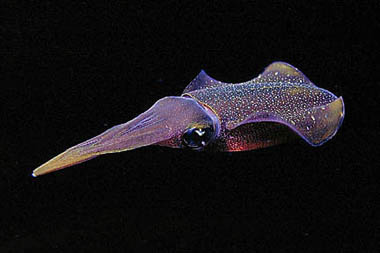
Food Habits
Small bony fishes, such as herring and sardines, and invertebrates, such as squid, cuttlefish and pelagic octopi, make up a majority of the blue shark’s diet. They feed actively at night but are known to feed throughout the 24 hours of the day (Stevens 2009). Blue sharks often aggregate to feed on schools of prey (Compagno et al. 2005).
Reproduction
Gestation periods of the blue shark range from 9 to 12 months and result in litters averaging about 30 individuals, but can have up to 80 pups in a litter. Pups are approximately 35-50 cm in length at birth. Blue sharks are viviparous, giving birth to live young that are nourished by a placental yolk sack internally until they are fully developed. Young are born in summer or spring (Stevens 2009).
Predators
Predators of the blue shark include killer whales (Orcinus orca) (Society for Marine Mammology 1996) and larger sharks including the shortfin mako (Isurus oxyrinchus) and the white shark (Carcharodon carcharias).
Parasites
A variety of copepods are known to use the blue shark as a host. Species of these copepods include Pandarus satyrus, which attaches itself to the pectoral fins, Kroeyerina elongata, which lives in the nose, Echthrogaleus coleoptratus, a body surface dweller, and Kroyeria carchariaeglauci and Phyllothyreus cornutus, both species that inhabit the gills. Parasite loads can exceed 3,000 individuals and can lead to sight impairments and changes in gill structure (Henderson et al. 2002).
Taxonomy
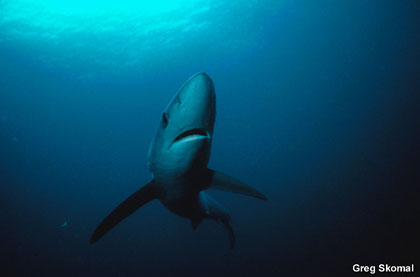
The blue shark was named Prionace glauca by Linnaeus in 1758. Prionace is derived from Greek, “prion” meaning saw and “akis” meaning point, while the species name glauca is derived from the Latin term “glaucas” meaning bluish gray or green in English, referring to the blue color of the shark. The following synonyms also appear in the literature Squalus glaucus Linnaeus 1758, Squalus caeruleus Blainville 1826, Thalassinius rondelettii Moreau 1881, Carcharias pugae Perez Canto 1886, Carcharias gracilis Philippi 1887 and Prionace mackiei Phillips 1934.
References
BIGELOW, H.B. & SCHROEDER, W.C. (1948)
Fishes of the western North Atlantic, Part I: Lancelets, Cyclostomes, Sharks. Memoirs of the Sears Foundation for Marine Research, 1 (1): 59–576
Compagno, L., Dando, M., & Fowler, S. (2005) A Field Guide to the Sharks of the World. London: Harper Collins Publishers Ltd.
Henderson, A. C., Flannery, K., & Dunne, J. (2002). Parasites of the blue shark (Prionace glauca L.), in the North-East Atlantic Ocean. Journal of Natural History, 36(16), 1995-2004.
Society for Marine Mammalogy. 1996. A report of Killer whales (Orcinus orca) feeding on a carcharhinid shark in Costa Rica. Marine Mammal Science, 12(4): 2.
Stevens, J. 2009. Prionace glauca. The IUCN Red List of Threatened Species 2009: e.T39381A10222811. http://dx.doi.org/10.2305/IUCN.UK.2009-2.RLTS.T39381A10222811.en.
Revised by Lindsay French and Gavin Naylor 2018
Original preparation by Pete Cooper
